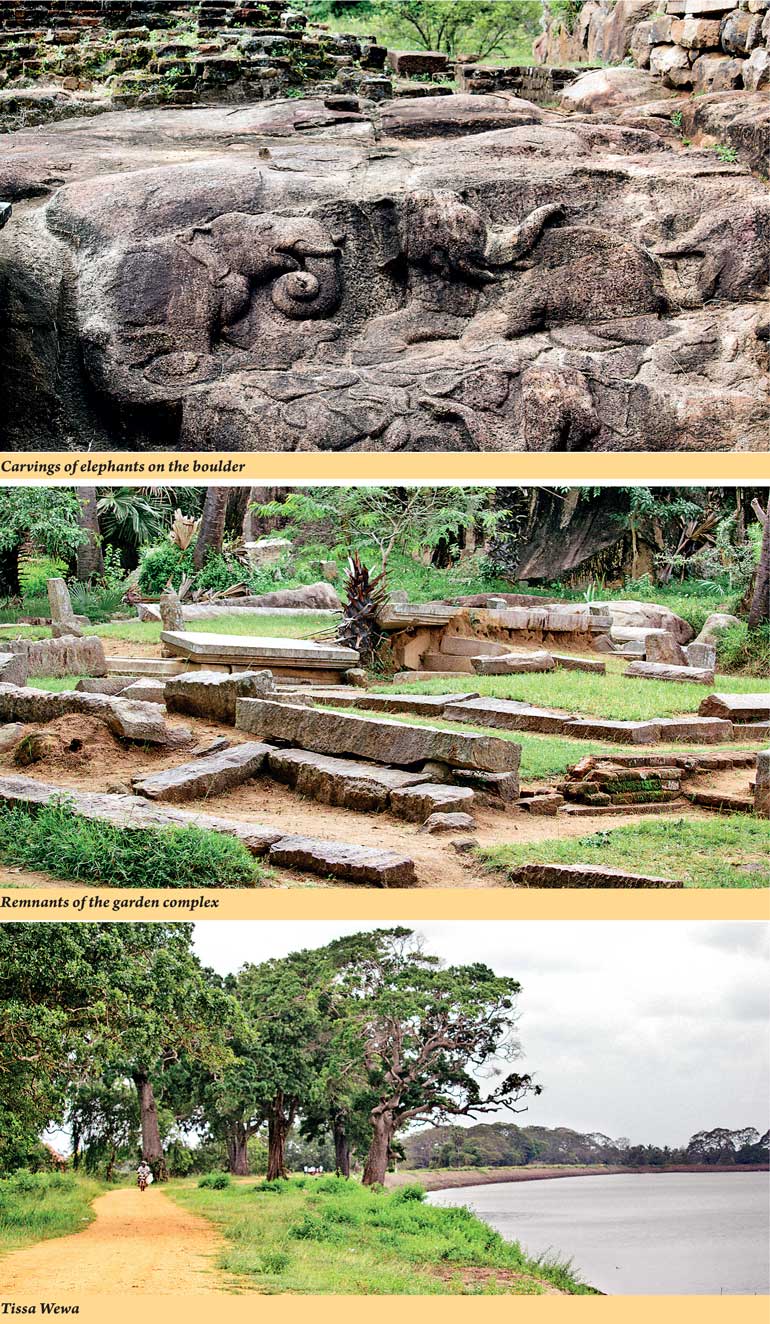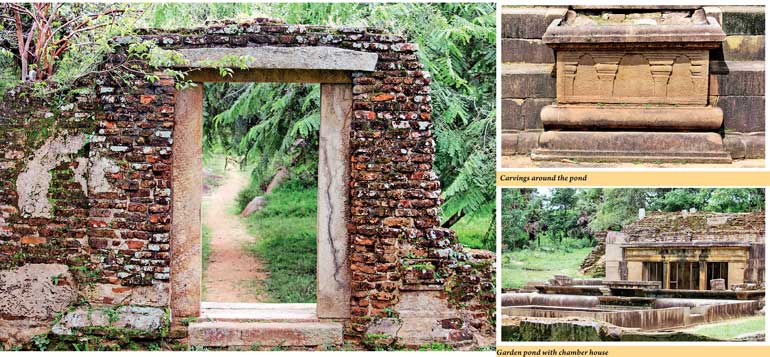Wednesday Feb 05, 2025
Wednesday Feb 05, 2025
Saturday, 6 January 2018 00:31 - - {{hitsCtrl.values.hits}}


By Aysha Maryam Cassim
According to Sinhalese literature, gardens and bathing complexes were one of the important aspects of Sri Lankan cultural life, which provided sensual enjoyment for Royalty. These boulder gardens were mostly associated with both monasteries and royal palaces and served a collective purpose at various stages in the history. Some were secular and the rest were used for recreation and meditation.
There are few monastic landscapes that can be found by the embankment of the Tissa reservoir at Anuradhapura. Ranmasu Uyana is an ancient royal park which is linked to a system of water hydraulics that funnels through pools. The water is then released into the nearby agricultural lands. The park covers around 12 hectares in extent and is surrounded by a wall and a moat.
The pleasure gardens were also known as Magul Uyana and served as an ancient recreation park once enjoyed by a succession of monarchs of ancient Anuradhapura over the centuries.
The Vessagiri inscription of Mahinda IV in the 10th century refers to this park as ‘Ranmasu Uyana’ (Gold Fish Park). According to the legends, it was in this Royal Park that King Dutugamunu’s only son Prince Saliya met Asokamala and renounced the throne out of love for her.
In terms of antiquity and degree of preservation, Ran Masu Uyana in Anuradhapura attracts quite a lot of attention after Sigiriya. The elaborately laid-out garden complex epitomises ancient Sri Lanka’s ingenious landscape architecture and engineering excellence.
The royal gardens of Ranmasu Uyana are shrouded with vines, flowery shrubs, trees and ponds. A pilgrim who visits Isurumuniya does not forget to pay a visit to the adjoining garden. Although the south end of the strip is mostly in ruins today, the topographical features of the park that consists of natural landscape and formal compositions of buildings can still be witnessed by any visitor.
Ranmasu Uyana showcases natural boulders and caves that were once used for meditation by monks who resided in Isurumuniya temple. Around the park, there are foundations of pavilions and garden structures that once perched on the rocks. On the rock are the remnants of a pleasure chamber that overlooked the garden and pools. Below the platform, there is a pavilion inside which there is a reclining couch made out of stone.
Scattered around the park are three bathing ponds in different sizes. In front of the larger pool, there is a small rectangular pool and right next to that there is another larger one. The largest is on the northern side with room cut into the stone. This room measures 7 feet x 6 feet.
On the southern side of the rocks, there is another twin pond with two units. In the interior, there is a chamber built with slabs of rock, presumably a changing chamber for the Royal family. Former Archaeological Commissioner S. Pranavitana believed that these joined ponds made a shower bath where the Royals were sprayed from water jets.
The ponds in the Royal gardens are designed with precision irrigation techniques. The complex system of channels, cisterns, sluices and drains are among the many interesting structures of the waterworks. One of these cisterns is situated at the end of the main canal, which brings in water from the Tissa Wewa. The water from the reservoir would pass through all the ponds and tanks in the garden before releasing them to feed the paddy fields in the village.
Engraved on to a rocky boulder there is a herd of elephants frolicking amongst lotuses. The carvings are strikingly similar to the ones at Isurumuniya temple. Van Lohuizen (1979:340) assigns the date of the rock-cut reliefs of elephants on either side of a royal bathhouse at Ranmasu Uyana to the late 7th century or 8th century AC.
Given its close proximity to Isurumuniya, he attributes the elephant carvings of Ran Masu Uyana to the same period as those at Isurumuniya. However, Dissanayake argues that (2003:55) the garden was established during the period from 3-1st century BC. Many other carvings of Ranmasu Uyana are displayed in Isurumuniya Museum.
Sakwala Chakraya also known as ‘The Star Gate’ is an extraordinary artefact that still intrigues the historians across the world. This curious and controversial circular diagram projects a great chakra (a circle) which is 6ft in diameter.
Incised shallowly on to a bare rock in Ranamasu Uyana, the chakra claims to depict an old-time cosmographical chart illustrating the Buddhist notions of the universe in most naive simplicity. The centre of the chakra is filled with concentric rings with interspaces. This could mean only the Sakwala, in the centre of which rises Maha Meru, surrounded by the seven seas and walls of rock. This “ancient map of the world” is believed to be the oldest in existence that testifies to the antiquity of astronomical lore in ancient Sri Lanka.
(Extracted from the annual report of Archaeological Survey of Ceylon – North Central and Central Provinces by H.C.P Bell, 1901.)